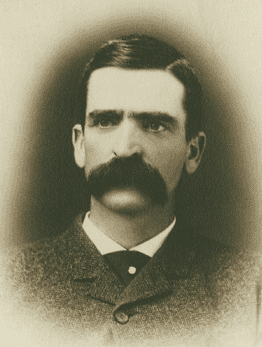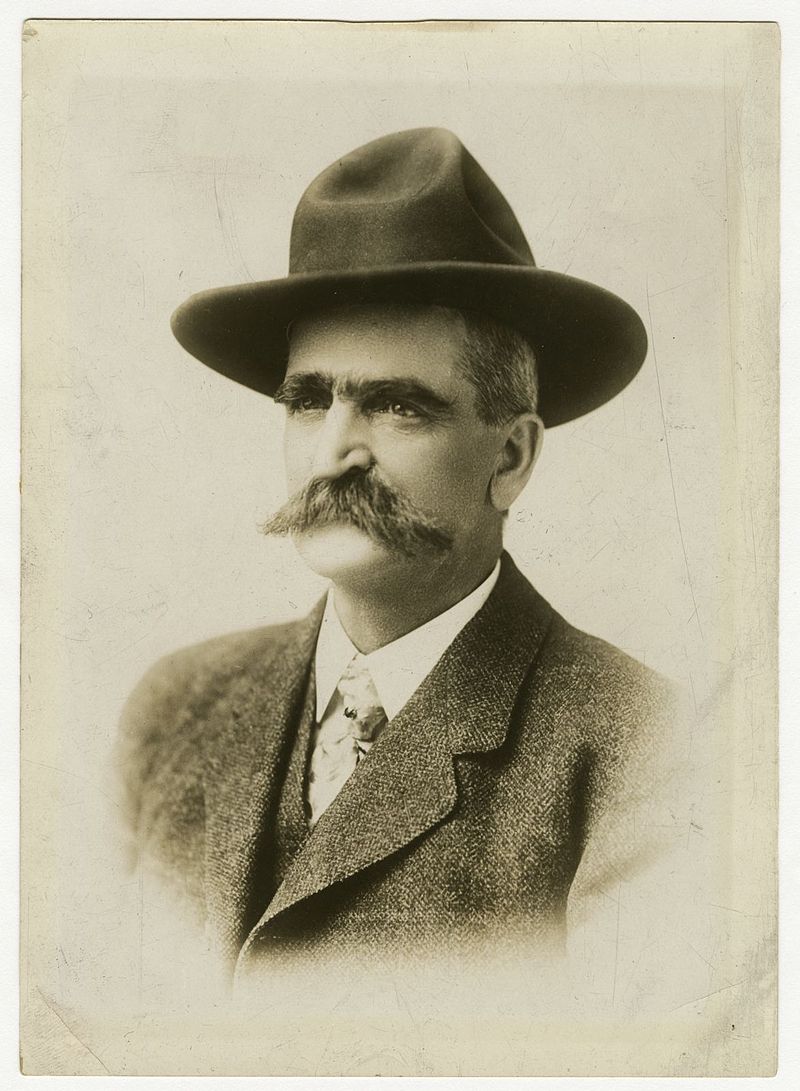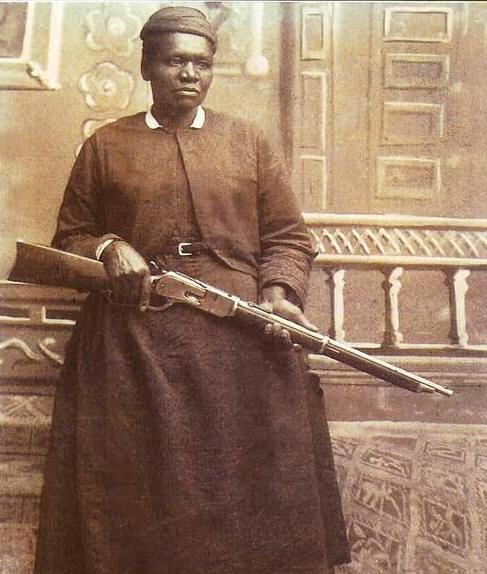Seth Bullock - from Wikipedia
Seth Bullock (July 23, 1849 – September 23, 1919) was
a Canadian-American Western sheriff, hardware store owner, and U.S. Marshal.
Early life
Many of the details of Bullock's early life are lost.
He was born in Amherstburg, Canada West (now Ontario) on the Canadian side
of the Detroit River.
His father, retired British Army Sergeant Major and hero
George Bullock, was known to be active in the politics of Sandwich, Canada
West (later renamed Windsor, Ontario). He has been mistakenly believed
to be related to British General George Bullock, Governor and Commander-in-chief
of Bermuda; however, Lieutenant General Sir George M. Bullock was a boy
and young man during Seth's exploits in Deadwood. Seth's mother was a Scotswoman
named Anna Findley Bullock.
Bullock was apparently not happy at home. His father was
a strict disciplinarian, known to beat young Seth for minor infractions.
Bullock ran away first at age 13, then again at age 16 to Montana to live
temporarily with his older sister, Jessie Bullock. By age eighteen, he
had permanently left home.
Helena
In 1867, Bullock became a resident of Helena, Montana,
where he unsuccessfully ran for the Territorial |

Seth Bullock |
Legislature. He was subsequently elected as a Republican
to the Territorial Senate, serving in 1871 and 1872 and helped create Yellowstone
National Park. In 1873, he was elected sheriff of Lewis and Clark County,
Montana. During his tenure as sheriff, he killed his first man, Clell Watson.
Watson had stolen a horse and engaged in a gunfight with Bullock, in which
Bullock was slightly wounded in the shoulder. Watson was then taken into
custody. Watson was prepared to be hanged, but a mob appeared and scared
off the executioner. Bullock climbed the scaffold and pulled the lever,
sending Watson to his death. Bullock then held off the mob with a shotgun.
This incident was recreated on HBO's Deadwood, except that Watson was hanged
on the step of the sheriff's office.
Around this time, Bullock and Sol Star opened a hardware
store. In August 1876, he and Star decided that an untapped market for
hardware existed in the gold rush town of Deadwood in the Dakota Territory.
The two purchased a lot in Deadwood and set up shop there as the "Office
of Star and Bullock, Auctioneers and Commission Merchants," first in a
tent and then a building
| Deadwood
Deadwood was a lawless, rowdy camp. The day after Bullock's
arrival, Wild Bill Hickok was murdered by Jack McCall. McCall shot Hickok
in the back of the head while he sat playing poker. McCall was later found
not guilty by an impromptu camp court and released, after which he promptly
left town. The demand for law enforcement grew following Hickok's murder
and Bullock's background made him the logical choice for Deadwood's first
sheriff.
Bullock took his job seriously, deputizing several residents
and tackling the job of civilizing the camp. Despite (or perhaps because
of) a reputation for fearlessness and an uncompromising nature, Bullock
managed the task without killing anyone. Bullock had several 'run ins'
with Al Swearengen, proprietor of the notorious Gem Theater, Deadwood's
most notable brothel. Swearengen had a knack for making money from vice
and shrewdly invested some of his profits in cultivating alliances with
the camp's wealthy and powerful.
When appointed sheriff, one of Bullock's first duties
was to confront Dodge City Deputy Marshal Wyatt Earp, who was possibly
interested in the sheriff's job. Bullock told Earp that his services were
not needed. A week later Earp left Deadwood to return to Dodge City.
Having attained some stability in Deadwood, Bullock brought
his wife Martha Eccles Bullock and daughter to town from her parents' home
in Michigan, where they had been living during this period. |

Seth Bullock
1893 |
They had one daughter, Margaret, at the time of Martha's
arrival in Deadwood, and they subsequently had another daughter, Florence,
and a son, Stanley.
Bullock and Star purchased a ranch where Redwater Creek
met the Belle Fourche River and dubbed it the S&B Ranch Company. Bullock
is also credited with introducing alfalfa farming to South Dakota in 1881.
Later he became a deputy U.S. Marshal, partnered with Star and Harris Franklin
in the Deadwood Flouring Mill, and invested in mining, the local growth
industry. Bullock and Star eventually expanded their business interests
to the towns of Spearfish, Sturgis, and Custer.
Bullock met Theodore Roosevelt, then a deputy sheriff
from Medora, North Dakota, in 1884 while bringing a horse thief known as
Crazy Steve into custody on the range, near what would become the town
of Belle Fourche. The two became lifelong friends, Roosevelt later saying
of Bullock, "Seth Bullock is a true Westerner, the finest type of frontiersman."
Belle Fourche and the Bullock Hotel
Bullock and Star contributed further to the economic development
of the region by convincing the Fremont, Elkhorn, and Missouri Valley Railroad
to build a track by offering them 40 acres (16 ha) of free right-of-way
across their land when a speculator purchased the right of way to Minnesela
and demanded a high price from the railroad. The railroad built a station
three miles (5 km) northwest of Minnesela in 1890, and Bullock and Star
were instrumental in founding the town of Belle Fourche, offering free
lots to anyone moving from Minnesela. Belle Fourche became the largest
railhead for livestock in the United States and the county seat was changed
from Minnesela to Belle Fourche.
Bullock and Star's hardware store in Deadwood burned down
in 1894. Rather than rebuild, they built Deadwood's first hotel on the
site—a three story, 63-room luxury hotel with steam heat and indoor bathrooms
on each floor, at a cost of $40,000. The Bullock Hotel continues to operate
to this day, now incorporating a casino.
Later life and death.
Bullock's friendship with Roosevelt led to his becoming
a Captain of Troop A in Grigsby's Cowboy Regiment. This was another volunteer
cavalry regiment which Congress authorized in the Spring of 1898. It was
similar in composition to Theodore Roosevelt's Rough Riders which saw action
in Cuba during the Spanish–American War. Although the troop never left
training camp in Louisiana before the war ended, Bullock still earned the
rank of captain. When Roosevelt became vice president under President William
McKinley, he appointed Bullock as the first forest supervisor of the Black
Hills Reserve. After Roosevelt was elected president, Bullock organized
50 people (including Tom Mix) to ride in the inaugural parade in 1905.
Bullock was then appointed U.S. Marshal for South Dakota for the next nine
years. Roosevelt later selected Bullock as one of 18 officers (others included
Frederick Russell Burnham, James R. Garfield, and John M. Parker) to raise
a volunteer infantry division, Roosevelt's World War I volunteers, for
service in France in 1917.
Congress gave Roosevelt the authority to raise up to four
divisions similar to the Rough Riders; however, as commander-in-chief,
President Woodrow Wilson refused to make use of the volunteers and the
unit was disbanded. After Roosevelt's death in January 1919, Bullock created
a monument to him with the aid of the Black Hill Pioneers, dedicated on
July 4, 1919, on Sheep Mountain, which was renamed Mount Roosevelt.
Bullock died of colon cancer shortly thereafter, on September
23, 1919, at his home at 28 Van Buren Street in Deadwood. He is buried
in Mount Moriah Cemetery in Deadwood, along with Wild Bill Hickok and Calamity
Jane, with his grave facing Mount Roosevelt. Bullock's grave is more than
750 feet away from the main cemetery grounds.
|
| Martha Bullock from Wikapedia
Martha Eccles Bullock (1851–1939) was the wife of Seth
Bullock, one of the leading citizens in early Deadwood, South Dakota. She
and Bullock were married in Salt Lake City, Utah, in 1874.
Martha Bullock and daughter Margaret were sent to live
with her parents in Michigan in 1876 when Bullock first left for Deadwood,
then a wild lawless frontier town and no place for a family; after the
town had become more orderly, largely as a result of the efforts of Bullock
himself as sheriff, they joined her husband in Deadwood. She became a leading
member of local society managing a household befitting the wife of one
of the area's leading citizens. They subsequently had another daughter,
Florence, and a son, Stanley.
In popular culture
Martha Bullock appeared as a supporting character in the
HBO television series Deadwood where she was portrayed by Anna Gunn. Several
creative liberties were taken with the facts surrounding the real Martha
Bullock for the show's character. Unlike her character in the TV series,
she was not originally the widow of Bullock's brother, but is reported
to have been his childhood sweetheart[citation needed]; and similarly,
rather than having a son by Bullock's brother, she and Bullock actually
had a daughter, Margaret, at the time of Bullock's departure for Deadwood.
|
| Cattle Annie from Wikapedia
Anna Emmaline McDoulet, known as Cattle Annie (November
29, 1882 - November 7, 1978), was a young American outlaw in the American
Old West, most associated with Jennie Stevens, or Little Britches. Their
exploits are known in part through the fictional film Cattle Annie and
Little Britches (1981), directed by Lamont Johnson and starring Amanda
Plummer in her film debut as Cattle Annie, with Diane Lane as Little Britches.
Cattle Annie and Little Britches were crack shots with
both pistol and rifle, but today they are mostly unknown outside of the
film. Yet they were once among the most recognized names among outlaws
in the Oklahoma and Indian territories, where they carried out their short-lived
criminal ventures.
Embracing the criminal element
Anna was born in Lawrence in Douglas County in eastern
Kansas, one of eight children of James C. and Rebekah McDoulet. When Anna
was four years old, the family moved to Coyville in Wilson County, in southeastern
Kansas. Anna worked as a hotel dishwasher and performed other odd jobs.
When she was twelve, the family moved to the Otoe Reservation near Skiatook
north of Tulsa in the northern Oklahoma Territory, where she turned outlaw.
Annie and Little Britches followed tales of the Bill Doolin gang from reading
dime novelists like Ned Buntline, who became famous for his mostly fictional
account of Buffalo Bill Cody as a western frontier hero and showman.
For two years, Cattle Annie and Little Britches roamed
the former Indian Territory, often working together and at other times
alone. They stole horses, sold alcohol to the Osage and Pawnee Indians,
and warned outlaw gangs whenever law-enforcement officers were nearby.
They wore men's clothing and packed pistols on their hips. Their adventures
netted headlines from Guthrie, the capital of the former Oklahoma Territory,
to Coffeyville in southeastern Kansas, where the Dalton gang attempted
to rob two banks simultaneously on October 5, 1892.
U.S. Marshal Steve Burke captured 13-year-old Cattle Annie
climbing from a window in 1895. (Marshal Bill Tilghman had a more difficult
task apprehending Little Britches, who engaged in a physical confrontation
with the famous lawman before he took her into custody.) Annie was sentenced
to one year in the Massachusetts Correctional Institution in Framingham.
Because of health issues, she was soon paroled. She remained in Framingham
for some time, having informed corrections officers that, if she returned
to Oklahoma, she would likely have fallen back into her criminal ways.
In 1898, she was working as a housekeeper for Mrs. Mary Daniels in Sherborn
in Middlesex County south of Framingham. A few months later, she may have
moved to New York City, where she may have died of tuberculosis.
Another scenario
Another legitimate report claims that Annie left Framingham
to return to Oklahoma where she wed Earl Frost of Perry on March 13, 1901.
The couple had two sons, Robert C. Frost (1903-1993) of Oklahoma City and
Carlos D. Frost, later of Malibu, California. The Frosts divorced in Noble
County, Oklahoma in October 1909, probably because Annie had joined a Wild
West show. The historical museum in Guthrie maintains that, soon after
the divorce from Frost, Annie married Whitmore R. Roach (1879-1947), a
Texas native, veteran of World War I, and painting contractor in Oklahoma
City, where they lived after 1912. They had resided from 1910 to 1912 in
Fort Worth, Texas. This "Emma McDoulet Roach" is interred at Rose Hill
Burial Park in Oklahoma City. She died in 1978, just short of her 96th
birthday. Her newspaper obituary makes no mention of her early days or
even the first name "Anna" but instead refers to "Emma", the shortened
form of "Emmaline". The obituary indicates that she had been a bookkeeper
in her later working career. Her services were held in her home church,
Olivet Baptist in Oklahoma City.
Meanwhile, Little Britches also served a short sentence
at the reformatory in Framingham, but her whereabouts thereafter is unknown.
Some reports indicate that Little Britches returned to Tulsa, where she
was married, had a family, and led an exemplary life.
In popular culture
Film
Johnson's film, Cattle Annie and Little Britches (1981),
features Burt Lancaster as an historically inaccurate and much older Bill
Doolin, Rod Steiger as Marshal William Tilghman, Scott Glenn as Bill Dalton,
and Buck Taylor, particularly known to audiences as the blacksmith-turned-deputy
Newly O'Brien on CBS's Gunsmoke, as the outlaw Dynamite Dick, presumably
Dan Clifton, called "Dynamite Dan.
|
Mary Fields from Wikapedia
| Mary Fields (c. 1832–1914), also known as Stagecoach
Mary and Black Mary, was the first African-American woman star route mail
carrier in the United States. She was not an employee of the United States
Post Office's; the Post Office Department did not hire or employ mail carriers
for star routes but rather awarded star route contracts to persons who
proposed the lowest qualified bids, and who in accordance with the Department’s
application process posted bonds and sureties to substantiate their ability
to finance the route. Once a contract was obtained, the contractor could
then drive the route themselves, sublet the route, or hire an experienced
driver. Some individuals obtained multiple star route contracts and conducted
the operations as a business.
Fields obtained the star route contract for the delivery
of U.S. mail from Cascade, Montana to Saint Peter's Mission in 1885. She
drove the route with horse and wagon, not a stagecoach, for two four-year
contracts: from 1885 to 1889 and from 1889 to 1893.
Author Miantae Metcalf McConnell provided documentation
discovered during her research about Mary Fields to the United States Postal
Service Archives Historian in 2006. This enabled USPS to establish Mary
Fields' contribution as the first African American woman star route mail
carrier in the United States. |

Mary Fields
1895 |
Biography
Early life and career
Born a slave in Hickman County, Tennessee, circa 1832,
Fields was freed when slavery was outlawed in the United States, in 1865.
She then worked in the home of Judge Edmund Dunne. When Dunne's wife Josephine
died in 1883, in San Antonio, Florida, Fields took the family's five children
to their aunt, Mother Mary Amadeus, the mother superior of an Ursuline
convent in Toledo, Ohio.
In 1884, Mother Amadeus was sent to Montana Territory
to establish a school for Native American girls at St. Peter's Mission,
west of Cascade. Learning that Amadeus was stricken with pneumonia, Fields
hurried to Montana to nurse her back to health. Amadeus recovered, and
Fields stayed at St. Peter's, hauling freight, doing laundry, growing vegetables,
tending chickens, and repairing buildings, and eventually became the forewoman.
The Native Americans called Fields "White Crow", because
"she acts like a white woman but has black skin". Local whites did not
know what to make of her. One schoolgirl wrote an essay saying, "She drinks
whiskey, and she swears, and she is a republican, which makes her a low,
foul creature."
In 1894, after several complaints and an incident with
a disgruntled male subordinate that involved gunplay, the bishop ordered
her to leave the convent. Mother Amadeus helped her open a restaurant in
nearby Cascade. Fields would serve food to anyone, whether they could pay
or not, and the restaurant went broke in about 10 months.
Postal service
In 1895, although approximately 60 years old, Fields was
hired as a mail carrier because she was the fastest applicant to hitch
a team of six horses. This made her the second woman and first African
American woman to work for the U.S. Postal Service.
She drove the route with horses and a mule named Moses.
She never missed a day, and her reliability earned her the nickname "Stagecoach".
If the snow was too deep for her horses, Fields delivered the mail on snowshoes,
carrying the sacks on her shoulders.
Later life
She was a respected public figure in Cascade, and the
town closed its schools to celebrate her birthday each year. When Montana
passed a law forbidding women to enter saloons, the mayor of Cascade granted
her an exemption. In 1903, at age 71, Fields retired from star route mail
carrier service. She continued to babysit many Cascade children and owned
and operated a laundry service from her home.
Death
Fields died in 1914 at Columbus Hospital in Great Falls,
but she was buried outside Cascade
|
.
All articles submitted to the "Brimstone
Gazette" are the property of the author, used with their expressed permission.
The Brimstone Pistoleros are not
responsible for any accidents which may occur from use of loading
data, firearms information, or recommendations published on the Brimstone
Pistoleros web site. |
|